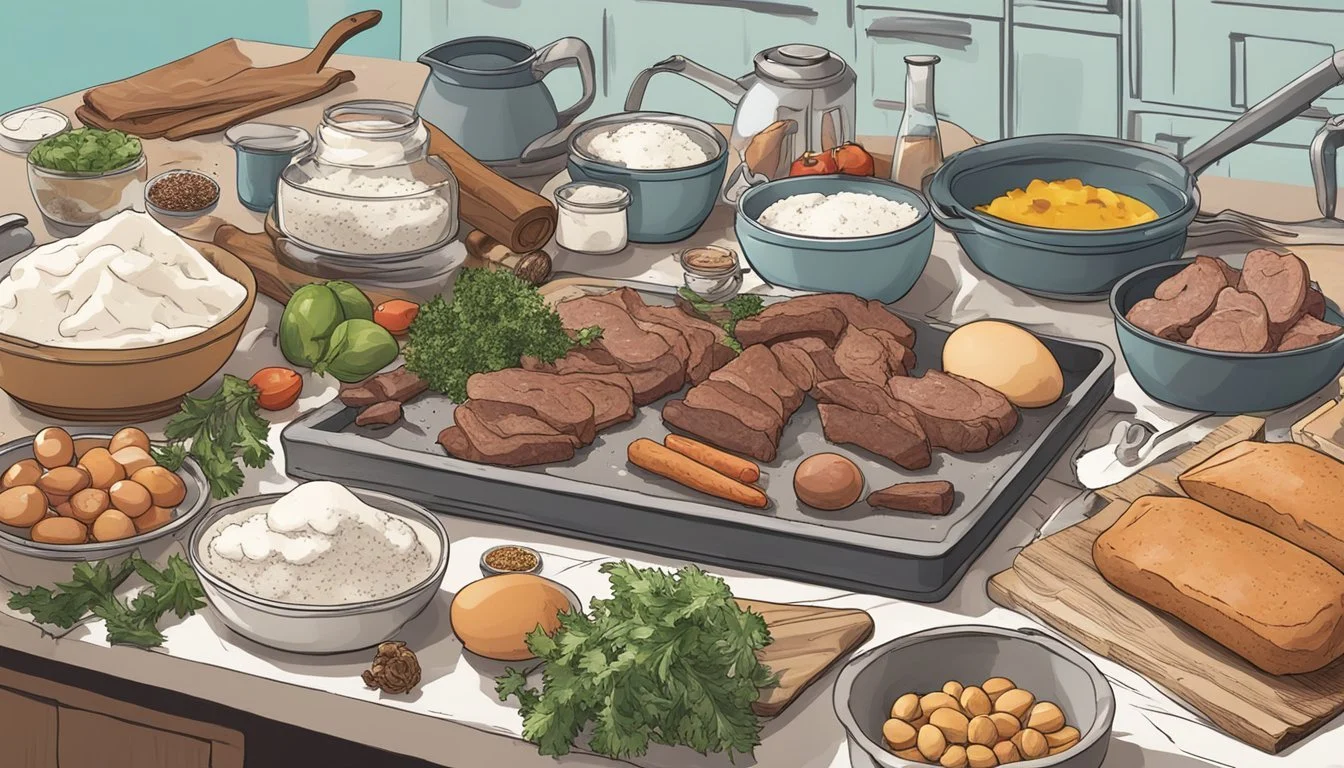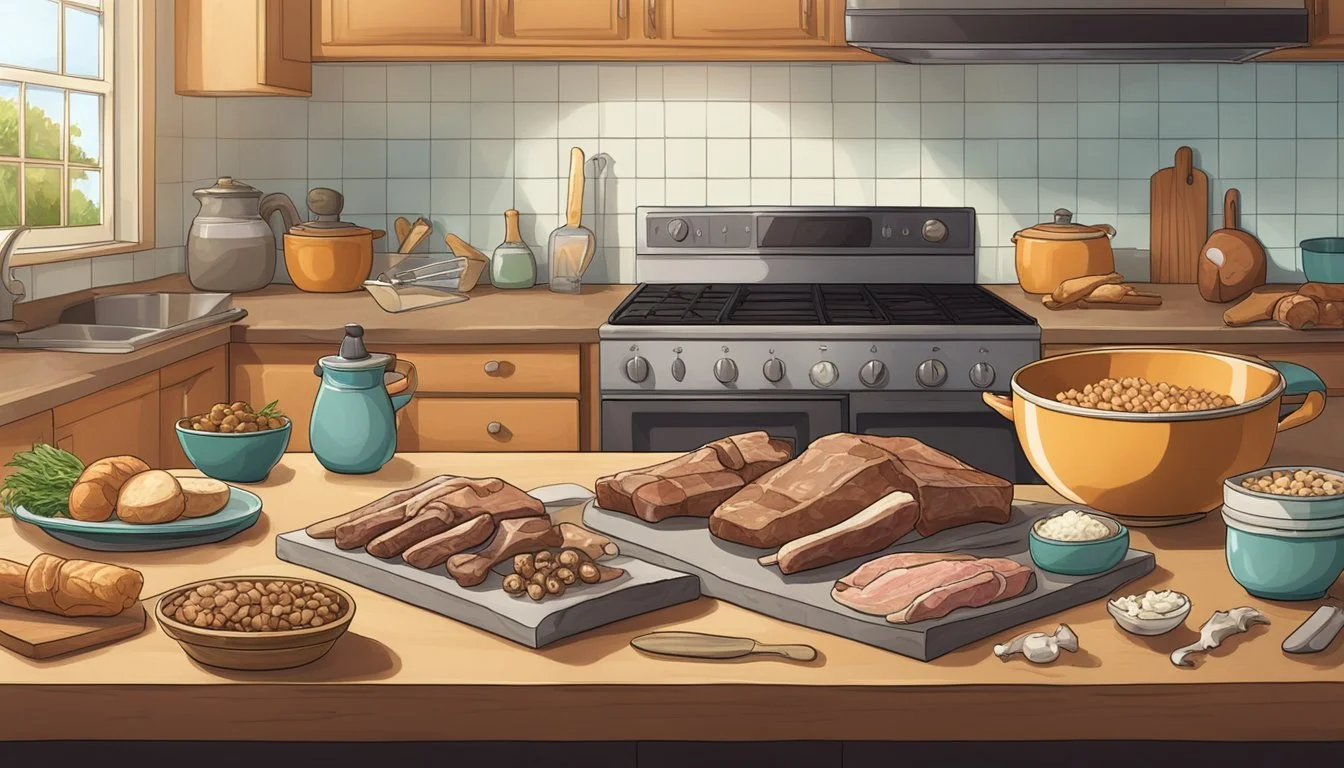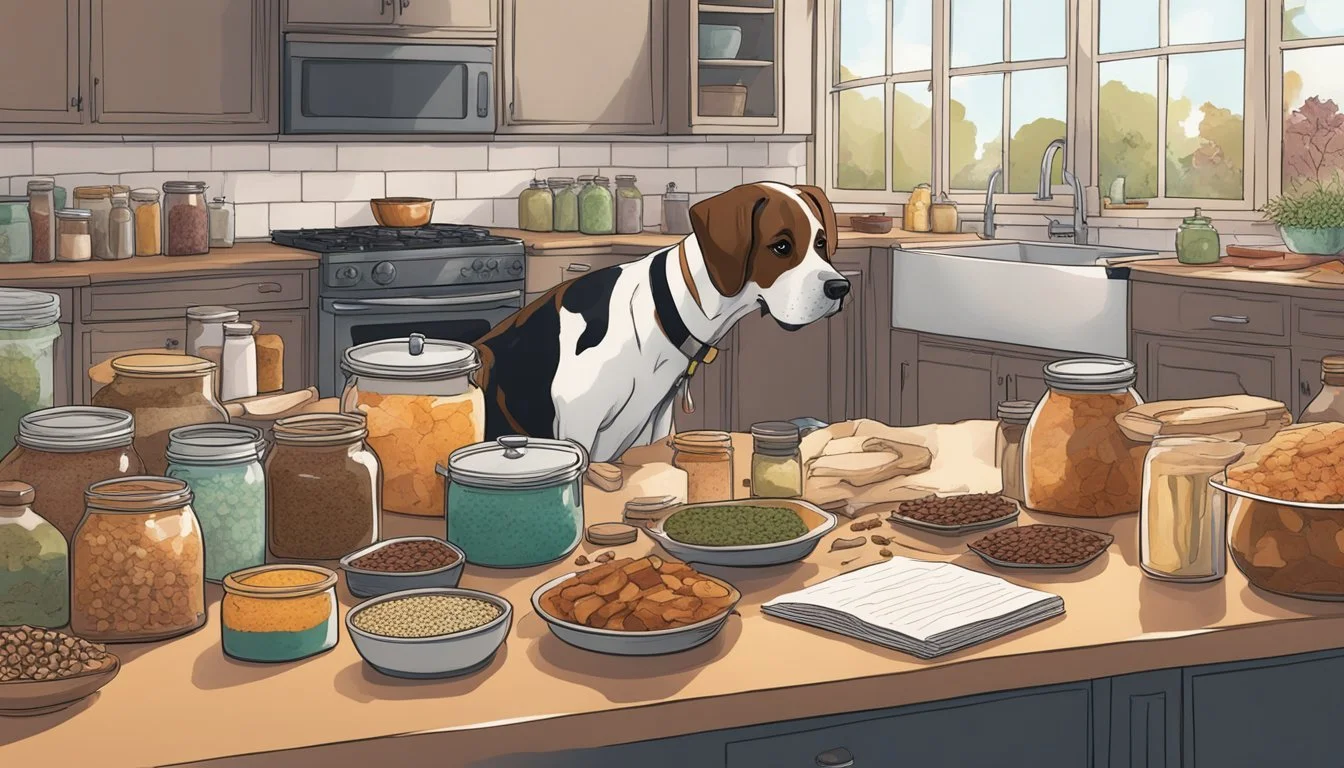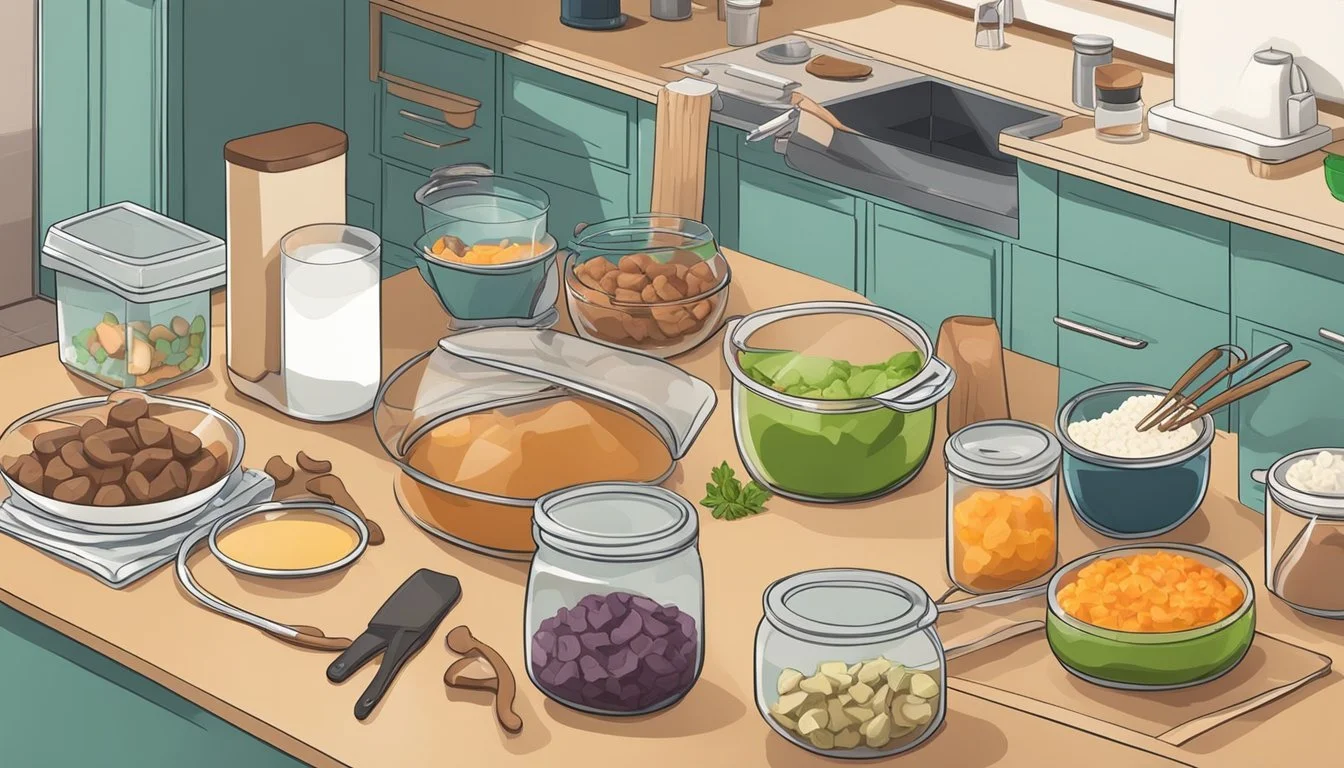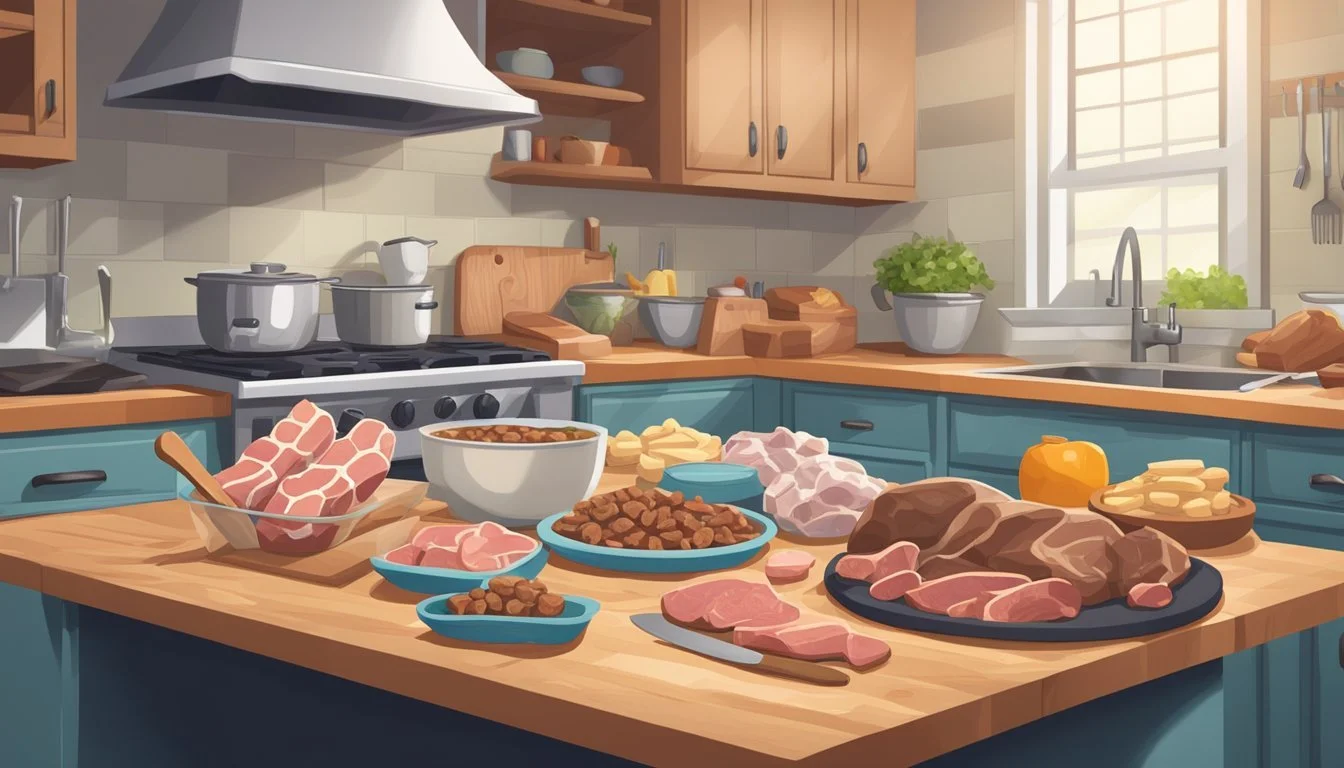Gourmet Dog Treats
Transform Leftover Meat and Bones into Nutritious Canine Snacks
Gourmet dog treats crafted at home offer pet owners a creative way to pamper their furry companions while ensuring the treats are both nutritious and tailored to the dog's palate. Utilizing leftover meats and bones not only reduces waste but also provides a rich source of protein and other nutrients for dogs. These treats can easily be made with simple ingredients that are often at hand, providing a cost-effective alternative to store-bought options.
Homemade dog treat recipes have surged in popularity among pet owners who desire control over their dog's dietary intake and wish to avoid the preservatives and additives found in many commercial treats. By following easy dog treat recipes using common leftovers, such as cooked meats or the remnants of a roast, pet owners can craft delicious and wholesome rewards for their pets.
These simple homemade dog treats can be customized for any occasion, whether for training purposes or just as a special snack. Creating them requires minimal effort and the process can be a bonding experience for owners and their dogs, who eagerly anticipate the tasty results. With a focus on health and flavor, homemade treats are a conscientious choice for those looking to improve their dog's well-being through diet.
Understanding Dog Nutrition
When preparing gourmet dog treats, it's essential to prioritize canine dietary requirements, focusing on the quality of ingredients and the balance of macronutrients.
The Importance of Proper Ingredients
Choosing the right ingredients for homemade dog treats is critical for your pet's health. Protein sources such as meat leftovers are vital, providing the amino acids dogs need for muscle maintenance and energy. However, not all proteins are equal; they should be lean and not excessively fatty to avoid high calories and fat content.
Fiber is another essential component, aiding in digestive health. Using ingredients like pumpkin or apple sauce in treats can help to provide this nutrient. Essential vitamins and minerals also need to be included in a dog's diet. For instance, carrots can be a great source of vitamin A, supporting eye health, while bones, if used correctly, can be a source of minerals like calcium.
Homemade treats should avoid high sodium and cholesterol levels, and instead include wholesome, natural foods without added sugars or artificial additives. It's vital to meet a dog's dietary needs while steering clear of ingredients that could harm them.
Balancing Macronutrients
Macronutrients — protein, fats, and carbohydrates — must be balanced carefully. Dogs require a considerable amount of protein, but it should be balanced with the right amount of fat for energy and fiber-rich carbohydrates for gastrointestinal health.
Protein: Should make up a substantial part of a dog's diet. Aim for proteins that are high-quality, such as cooked lean meats.
Fat: Needed for energy, but it's important to keep the fat content moderate to prevent obesity.
Carbohydrates: While not as critical as protein or fat, carbohydrates are necessary for energy and can be a good source of fiber. However, they should not be the main focus of the diet.
Here's a simple guideline for macronutrient distribution in a healthy dog treat:
Macronutrient Percentage of Treat Composition Protein 18-25% Fat 10-15% Carbohydrates 50-60%
By understanding and implementing these nutritional basics, homemade dog treats will not only be enjoyable but also contribute to a balanced and healthful diet for dogs.
Essential Equipment and Preparations
Creating gourmet dog treats at home begins with having the right tools on hand and ensuring your workspace is well-organized. This foundation minimizes potential hiccups and leads to a smoother cooking experience.
Selecting the Right Baking Tools
To begin, chefs will need a variety of baking sheets; heavier sheets prevent burning and provide even heat distribution. Silicone baking mats or parchment paper can be used to line these sheets for non-stick properties and easy cleanup. For cutting out treats, a variety of cookie cutters, including a dog bone cookie cutter, should be selected based on the size of the intended treat recipient. To check for doneness and ensure safety, a reliable oven thermometer is indispensable. Finally, cooling is just as crucial as baking, necessitating the use of wire racks which allow air to circulate around the treats, preventing any sogginess.
Baking Tools Checklist:
Heavy-duty baking sheets
Silicone baking mats or parchment paper
Variety of cookie cutters (dog bone shape optional but recommended)
Oven thermometer
Wire racks for cooling
Preparing Your Workspace
Preparation of the cooking area is paramount. Begin by cleaning the kitchen countertops to prevent contamination. Next, gather all necessary ingredients and tools to ensure they are within reach when the process begins. A floured surface is needed when rolling out dough, so clear a large workspace and sprinkle it lightly with flour to prevent sticking. Organize ingredients and tools such that they follow the flow of the recipe's steps. This strategic setup reduces cross-contamination and streamlines the baking process.
Workspace Preparation Tips:
Clean and sanitize countertops.
Organize tools and ingredients in the order of use.
Prepare a well-floured surface for rolling out dough.
Safe Ingredients for Dogs
When crafting gourmet dog treats, one must prioritize ingredients that are both safe and nutritious for canines. Choosing the right meats, vegetables, and fats is essential to ensure the health and well-being of the dog.
Choosing Meats and Proteins
Meats and proteins are the cornerstone of a dog's diet. Chicken is a lean and highly digestible protein that is often used in homemade dog treats. It should be cooked thoroughly without any added seasonings. Beef broth can be used to add flavor, provided it is low-sodium and free from onions or garlic. Eggs are another excellent source of protein and can be included in the treats either boiled or cooked. When using peanut butter, it's imperative to choose a natural variety that does not contain xylitol or excessive sugar.
Acceptable Vegetables and Fruits
While dogs primarily require proteins, certain vegetables and fruits can be excellent additions to their treats. Carrots are beneficial for their fiber content and can aid in dental health. Sweet potatoes (What wine goes well with sweet potatoes?) are rich in vitamin A and fiber and should be served cooked. Always remember to cut these vegetables into appropriate sizes to prevent choking hazards.
Healthy Fats and Oils
Fats and oils play an important role in a dog's diet by supporting skin and coat health, among other benefits. Coconut oil is known for its healthy fatty acids and can be added in moderation to homemade dog treats. Unsalted butter can be used sparingly to bind ingredients and add flavor to the treats. Remember, when it comes to fats and oils, less is more to maintain a healthy weight for the dog.
Crafting Recipes with Leftover Meats and Bones
When making gourmet dog treats at home, one can utilize leftover meats and bones to create both delicious and nutritious snacks (What wine goes well with snacks?). These ingredients are not only cost-effective but also add valuable proteins and minerals to a pet's diet.
Incorporating Meat Scraps
Meat scraps, perfect for re-purposing, can be easily included in homemade dog treats. One should ensure the meat is thoroughly cooked and free from any seasonings that may be harmful to dogs. Here is a basic process for incorporating meat into dog treats:
Preheat the oven to 350°F.
Finely chop or grind the leftover meat until it is small enough not to pose a choking hazard.
Combine the meat scraps with binding ingredients such as:
Whole wheat flour or oat flour
Eggs for added protein
A spoonful of unsweetened applesauce for moisture
Form the mixture into small, bite-sized pieces appropriate for the dog’s size.
Bake for about 25 minutes or until the treats are cooked through and have a firm texture.
Creating Nutritious Bone Broths
Scraps and bones rich in collagen can be transformed into a wholesome bone broth, an excellent source of nutrients for dogs. To make bone broth:
Simmer the bones in a large pot of water, ensuring the bones are fully submerged.
Add a splash of apple cider vinegar to help extract the nutrients from the bones.
Cook on a low simmer for 24 hours, which allows for the maximum release of collagen into the broth.
Strain the broth to remove any bone fragments and let it cool.
Serve the bone broth directly or incorporate it into other treats as a liquid ingredient.
One may store the bone broth in the refrigerator for up to a week or freeze it in ice cube trays for prolonged use. When crafting dog treats with bone broth, it can be mixed with flour to create a dough or used as a base for dehydrated meats.
Step-by-Step Homemade Dog Treats
Creating homemade dog treats is a straightforward process that involves mixing whole wheat flour and oats to form a healthy dough, baking until the treats reach the perfect consistency, and storing them properly to ensure freshness.
Mixing and Forming Dough
A chef begins by preheating the oven, setting it typically around 350ºF (175ºC). They combine 2 cups of whole wheat flour with 1 cup of oats in a large bowl. Pieces of leftover meat or a handful of crushed bones—ensured to be safe and without splinters—are added for flavor and nutrition. Gradually, they incorporate enough water to bring the mixture together until a firm yet pliable dough forms.
Ingredients for Dough:
2 cups whole wheat flour
1 cup oats
Leftover meat or safe bones
Water as needed
To create the treats, the chef rolls the dough on a flat surface to a thickness of about 1/4 inch. They then use cookie cutters to cut the dough into shapes suitable for the dog's size.
Baking Dog Treats to Perfection
With the dough shaped, the chef places the treats on a lined baking sheet. They make sure to space them out to provide even airflow and baking. The treats are then baked in the preheated oven. The baking time varies, but generally, they should be left for 12-15 minutes. The chef checks for a golden-brown finish and that they're drawing away from the sides of the pan, indicating they are done.
Baking Instructions:
Preheat oven to 350ºF (175ºC).
Place treats on a baking sheet.
Bake for 12-15 minutes.
Cooling and Storing Treats
After baking, the chef transfers the treats to a wire rack allowing them to cool completely. This step is crucial to avoid moisture buildup which can lead to mold. Once cooled, the treats are ready to serve, but surplus should be stored in a sealed container or treat jar to maintain freshness. The treats can also be frozen for long-term storage. To freeze, they are arranged in a single layer on a baking sheet, placed in the freezer until solid, and then transferred to a freezer-friendly, sealed container.
Storage Tips:
Cool treats completely on a wire rack.
Store in a sealed container or treat jar.
Freeze for long-term storage.
Special Treat Varieties
Creating gourmet dog treats at home allows for a range of specialized options that cater to different dietary needs and preferences. Home cooks can craft treats using leftover meats and bones, while also incorporating a variety of flours and ingredients to suit any dog's palate.
Vegetarian and Vegan Options
For dogs with meat sensitivities or for pet owners seeking plant-based alternatives, vegetarian dog treats are a viable option. They can utilize ingredients like sweet potato dog chews, which offer a chewy texture and rich flavor. Rice flour or oat flour can serve as the base for these treats, providing a source of energy and fiber.
Sweet Potato Chews: Slice sweet potatoes thinly and dehydrate or bake until chewy.
Veggie Biscuits: Combine oat flour, mashed peas, and grated carrots to form a dough, then bake.
Grain-Free and Gluten-Free Treats
When dogs have allergies or sensitivities to grains, grain-free and gluten-free treats offer a solution that does not compromise on taste. Coconut flour serves as an excellent gluten-free alternative that is both low in carbohydrates and high in fiber.
Grain-Free Meaty Bites: Mix ground leftover meat with coconut flour and an egg, roll into bite-sized balls, and bake.
Bone Broth Pops: Freeze bone broth in ice cube trays for a simple, grain-free treat.
Frozen Dog Treat Recipes
Frozen treats are perfect for cooling down on hot days and they're simple to make. Frozen dog treats can range from simple to complex, depending on the ingredients at hand.
Meat and Veggie Popsicles: Blend cooked meat with pureed pumpkin or carrots and freeze in molds.
Peanut Butter Banana Flats: Mix mashed banana with peanut butter, spread on a tray, and freeze before breaking into pieces.
Flavorful Additions and Seasonings
When preparing gourmet dog treats at home using leftover meat and bones, the right seasonings can greatly enhance the flavor without compromising the health of the dog. It's important to choose dog-safe herbs, spices, and natural flavor enhancers that provide both taste and nutritional benefits.
Herbs and Spices That Are Safe for Dogs
Parsley: A sprinkle of fresh or dried parsley can freshen up your dog's breath and provide a mild flavor to treats. Parsley is high in vitamins and is safe for dogs in moderation.
Beef Bouillon: A small amount of beef bouillon can intensify the meaty taste of dog treats. Opt for low-sodium versions to keep it healthy for the canine.
Natural Flavor Enhancers
Natural Peanut Butter: Always select natural peanut butter that does not contain xylitol or added sugars. It can serve as a delicious and flavored binder in biscuit recipes.
Broth: Whether it's made from bones or meat, unsalted broth can act as an excellent natural flavor enhancer when mixed into doughs or poured over kibble.
Troubleshooting Common Baking Issues
Baking homemade dog treats requires attention to dough consistency and oven temperatures. These factors can affect both the texture and the palatability of the treats.
Achieving the Right Dough Consistency
To ensure the dough reaches the right consistency, one must balance the dry and wet ingredients. If the dough is too sticky, it may be challenging to shape the treats and could result in uneven baking. To correct a sticky dough, one can gradually add small amounts of oat flour until the desired consistency is achieved. Conversely, if the dough is crumbly, a bit more applesauce or another binding wet ingredient can help to moisten it.
Sticky Dough:
Add oat flour, 1 tablespoon at a time
Mix thoroughly after each addition
Crumbly Dough:
Incorporate wet ingredients, 1 teaspoon at a time
Knead gently for even distribution
Adjusting Cooking Times and Temperature
The cooking time and temperature must be carefully regulated. An oven's calibration can sometimes be off, leading to treats that are either under or over-baked. Use an oven thermometer to accurately gauge the internal temperature. As a general rule, dog treats should be baked until they are firm and golden-brown, which may vary according to the size and thickness of the treats.
For chewier treats: bake for fewer minutes at a slightly higher temperature.
For crunchier treats: extend baking time at a lower temperature.
The proper use of oven settings and vigilantly monitoring the baking process can ensure homemade dog treats turn out perfectly every time.
Nutrition and Portioning
When creating homemade gourmet dog treats using leftover meat and bones, it's essential to ensure that the treats are not only tasty but also nutritious and appropriately portioned for the dog's size. An understanding of the calorie content and nutritional values of the ingredients used is critical for a pet's health and well-being.
Calculating Treat Size Based on Dog Size
Small Dogs (up to 20 lbs): Treats should be about the size of a pea to prevent choking and overfeeding—approximately 5-10 calories per treat.
Medium Dogs (20-50 lbs): A treat roughly the size of a marble, around 15-25 calories, balances enjoyment with dietary moderation.
Large Dogs (50+ lbs): A larger treat, akin to the size of a golf ball and not exceeding 40-50 calories, provides an appropriate reward without unnecessary weight gain.
One should carefully adjust treat portions in relation to the dog's total daily calorie allowance, ensuring that treats make up no more than 10% of a dog's daily intake to maintain a balanced diet.
Providing Nutritional Information for Treats
Nutritional balance in homemade treats is important to support a dog's health. A high-quality treat should contain a balanced ratio of protein, fat, carbohydrates, fiber, and other nutrients. One should strive for:
Protein: Essential for muscle repair and growth; leftover meats are an excellent source.
Fat: Provides energy; use sparingly to avoid obesity.
Carbohydrates: Offer energy and should come from digestible sources like rice or oat flour.
Fiber: Important for digestion, can be sourced from pumpkin or sweet potato.
For precise nutritional information, one may consider consulting with a veterinary nutritionist, especially if the dog has specific dietary needs. Using a nutritional analysis tool or software may also aid in ensuring that treats contribute positively to the pet's diet.
Packing and Presentation
When it comes to gourmet dog treats, presentation heightens the perceived value, making even DIY treats appear luxurious. The right packaging can not only ensure the treats stay fresh but also transform them into charming gifts.
Creating Attractive Treat Packaging
High-quality packaging for homemade dog treats can rival that of expensive, store-bought, organic options. Materials: To begin, one needs to consider materials that maintain freshness. Glass jars with airtight seals, metal tins, and cellophane bags are popular choices. Labeling: The next step involves adding a personal touch with labels. For baked dog treats, use labels that specify the ingredients and the baking date to emphasize the freshness and the organic nature of the treats. Appearance: The visual appeal can be increased by tying a ribbon around the jar or tin, choosing colors that correspond with the flavor of the treats, e.g., red for beef or green for chicken.
Homemade Treats as Gifts
Treating homemade dog treats as gourmet gifts requires an additional layer of thoughtfulness. Gift Tags: Attach a handwritten note or a custom-designed gift tag to personalize the treat for the recipient. Instruction Card: It's also beneficial to include a card with feeding instructions and any benefits the treats offer, such as dental health or coat improvement. For treats made with leftover meat and bones, emphasize the repurposing aspect, which appeals to environmentally-conscious pet owners. Packaging Choices: Opt for compostable or recyclable materials for the packaging to align with an eco-friendly message.
Health and Safety Considerations
When preparing gourmet dog treats using leftover meat and bones, pet owners must prioritize their dog's health and safety. Chicken meat is a popular choice due to its lean protein content, but it's essential to ensure that all bones are removed as they can splinter and pose a choking hazard or cause internal injury.
Boiling water can be used to cook the meat thoroughly, killing harmful bacteria; however, one must allow the meat to cool completely before offering it to their pet. Salt should be avoided in recipes for dog treats because dogs' tolerance to sodium is much lower than humans'. Even small quantities can be harmful, potentially leading to sodium ion poisoning.
Sugar is also detrimental to dogs' health, contributing to obesity, dental problems, and diabetes. Therefore, any recipe should omit sugar and artificial sweeteners, especially xylitol, which is toxic to dogs.
Lastly, while milk is often misconceived as a healthy treat for dogs, many canines are lactose intolerant. Using milk in dog treat recipes may lead to gastrointestinal issues. It's best to use lactose-free alternatives or skip it entirely.
Ingredient Considerations Chicken meat Remove all bones and cook thoroughly. Boiling water Cool cooked meats before serving. Salt Exclude due to low sodium tolerance in dogs. Sugar Avoid completely, as it is unhealthy for dogs. Milk Consider lactose intolerance; use substitutes.
Recipes for homemade dog treats should always prioritize the pet's well-being and dietary needs, avoiding ingredients that may cause health issues.

